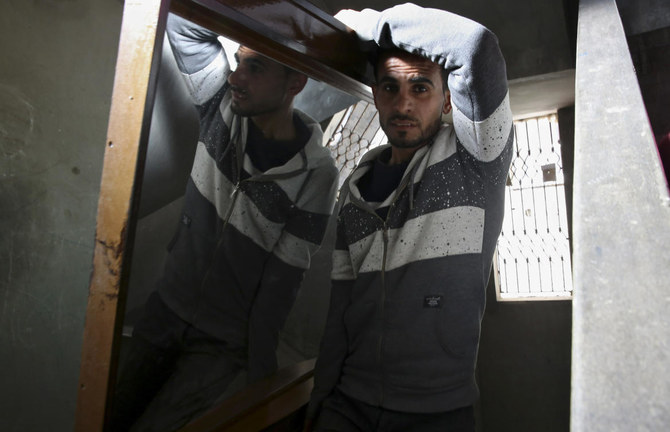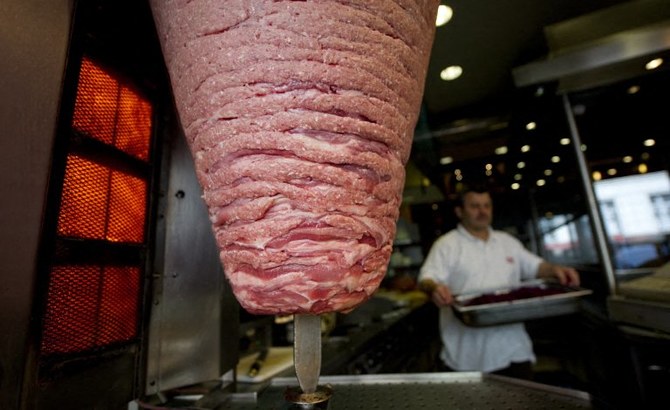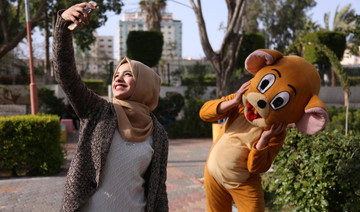GAZA CITY, Gaza Strip: Two years ago, Gaza resident Saleh Abu Serdanah took out a small loan in order to get married and start a family. These days, the 31-year-old construction worker is on the run, hiding from police in a tiny rental apartment and unable to repay the money he borrowed.
Abu Serdanah is among hundreds of young men who have turned to Gaza’s small industry of wedding lenders for help, only to fall onto hard times because of crushing debt and lack of jobs in the impoverished territory. Many have been forced to renegotiate their debts, and others have gone into hiding. Some have even ended up in jail.
“I have never been into a police station and have never made troubles. Now I’m like a fugitive crook,” Abu Serdanah said.
Wedding lenders have filled an important need in Gaza’s conservative society, where young men and women are typically expected to marry in their late teens or early 20s. Facing a nearly 60 percent unemployment rate, many young Gazan men have been forced to put off their dreams of marriage because they cannot afford it.
Over a decade ago, a number of wealthy people launched charities to help young couples to pay for their weddings and settle post-marriage debts. The initiative was promoted through ceremonial mass weddings that thrived after Israel and Egypt imposed a blockade on Gaza after the Hamas militant group took power in 2007.
These charitable efforts, which still continue, paved the way for a profitable private industry to emerge, offering more substantial packages that included things like bridal dresses, invitations, bedroom furniture and meals for guests.
Allured by the idea, Abu Serdanah signed up for an offer of $2,500 through Farha Project, one of those companies, in 2017. He acknowledges that he would never have been able to marry without Farha. The November 2017 wedding included a bachelor’s party with a live band and a separate women’s ceremony the following day. The company threw in invitations, catering for 60 people and a suit and dress for the couple.
Abu Serdanah agreed to repay the money in monthly payments over two years, but managed to pay only for five months. Today, he regrets his decision.
“I was committed to paying on time for a while, but things have changed and made me unable to,” said Abu Serdanah, sitting on a mat outside the apartment he shares with his wife as a candle faintly lit the dark stairway. “There is no work, so where should I get money from?”
The blockade, aimed at weakening Hamas, has ravaged the economy. The skyrocketing unemployment rates, combined with foreign aid cuts and Hamas’ mismanagement, has left thousands of families dependent on food aid and social welfare.
Economic sanctions by the West Bank-based Palestinian Authority, ousted by Hamas in 2007, have worsened the situation. The internationally recognized Palestinian Authority says its measures, which include salary cuts to tens of thousands of former public servants, are aimed at pressuring the militant Hamas group into ceding control.
Hamas, however, remains in firm control, even as the World Bank says Gaza’s economy is in “free fall.”
A plasterer who earns 50 shekels, or about $15, a day, Abu Serdanah was certain that he would be able to manage the payments to Farha.
But due to the weak economy, there have been few workdays and he was unable to pay back his debt. Trying to save himself from prison, he asked the company to reduce his monthly installment by 50 percent, but its lawyer refused. Eventually, a police summons was delivered to his family’s home. He decided not to respond.
“I don’t want to stall for time, but I really can’t pay for now,” he said.
The Hamas-run Economy Ministry says at their peak, 20 such companies were registered in Gaza. But their number has dropped to five as business has withered up. The Hamas-run prosecutor’s office, the judiciary council and the police refused requests to interview people jailed for failing to pay their marriage debts, or even reveal their number.
But an official at Gaza’s general prosecution department, speaking in condition of anonymity because he was not authorized to talk to the media, said that as of last year, courts have investigated 3,000 such cases.
This explains why the business is no longer thriving. Salama Al-Awadi, manager of Farha Project, says only 7 percent of his clients managed to pay the monthly installments fully this year and 40 percent could not pay back at all. The others pay less than the agreed amount.
“We see with our eyes that the situation is hard, so we try all possible ways before resorting to the courts,” Al-Awadi said, noting that his company has fallen into debt because of its customers’ struggles. Unable to collect payments, Farha owes money to service providers like carpenters and caterers.
With economic recession in Gaza, the number of clients is also dwindling. In 2018, the average monthly number of grooms signing up for contracts at Farha was 20. The year before, it was 35.
“This year would be way less,” Al-Awadi said. “I canceled many contracts and our plan for 2019 is to get by with the minimum. If it remains like this, I will have no choice but to shut down.”
One of Al-Awadi’s clients is 29-year-old Yehiya Taleb, whose four brothers, all married, believed it was problematic by Gaza’s standards to reach that age and still be single.
Taleb got a job working as a waiter at a cafe earning about $180 a month but that amount is not enough to cover wedding expenses. Anxious to fulfil the wish of their ailing mother, the brothers resorted to Farha Project and took out a $2,000 package.
After getting married early in May, Taleb and his wife now share a rental house in the Shati refugee camp with another brother’s family. Afraid of “failure,” he is already stressed out over how to repay the loan. He hopes to make ends meet with some help from his brothers.
“My salary can’t cover my demands. With installments, you can cover a little part of them,” he said.
For Gaza grooms, crippling debt overshadows marital bliss
For Gaza grooms, crippling debt overshadows marital bliss

- Wedding lenders have filled an important need in Gaza’s conservative society
- But their number has dropped to five as business has withered up due to the blockade
Meaty issue: German political party calls for €4.90 price cap on doner kebabs

- Die Linke appeals to government as price of national favorite hits €10 in some cities
- Scheme would cost taxpayer about €4bn
LONDON: German political party Die Linke has urged the government to cap the price of a much loved food item — the doner kebab.
The party has proposed providing daily vouchers to households that would limit prices to €4.90 ($5.28) and €2.90 for young people under an initiative known as Donerpreisbremse.
The scheme is projected to cost the government about €4 billion.
Introduced after the Second World War by Turkish immigrants who adapted the dish to suit local tastes, the doner kebab is a national favorite in Germany, with an estimated 1.3 billion consumed annually. But their soaring price has become a hot-button political issue.
Die Linke said the cost of a doner kebab had reached €10 in some cities, from €4 just two years ago.
“For young people right now it is an issue as important as where they will move when they leave home,” said Hanna Steinmuller, a lawmaker with the Greens party.
“I know it’s not an everyday issue for many people here … but I think as voter representatives we are obliged to highlight these different perspectives.”
German Chancellor Olaf Scholz was famously confronted by a voter last year who demanded he “speak with Putin … I’m paying €8 for a doner.”
With public pressure mounting, Scholz recently acknowledged on social media that “everywhere I go, mostly by young people, I get asked if there should be a price cap for doner kebabs.”
Despite the appeals, the chancellor rejected the proposal, citing the impracticality of price controls in a free market economy.
Despite its humble origins as a street food, the doner kebab has become an unexpected point of political focus.
Last month, German President Frank-Walter Steinmeier sparked controversy when on a visit to Turkiye he gifted 60 kg of kebab meat from Berlin to Istanbul in what some called a clumsy attempt to symbolize the strong cultural ties between the two nations.
A 98-year-old in Ukraine walked miles to safety from Russians, with slippers and a cane

- Describing her journey, the nonagenarian said she had fallen twice and was forced to stop to rest at some points, even sleeping along the way before waking up and continuing her journey
KYIV, Ukraine: A 98-year-old woman in Ukraine who escaped Russian-occupied territory by walking almost 10 kilometers (6 miles) alone, wearing a pair of slippers and supported by a cane has been reunited with her family days after they were separated while fleeing to safety.
Lidia Stepanivna Lomikovska and her family decided to leave the frontline town of Ocheretyne, in the eastern Donetsk region, last week after Russian troops entered it and fighting intensified.
Russians have been advancing in the area, pounding Kyiv’s depleted, ammunition-deprived forces with artillery, drones and bombs.
“I woke up surrounded by shooting all around — so scary,” Lomikovska said in a video interview posted by the National Police of Donetsk region.
In the chaos of the departure, Lomikovska became separated from her son and two daughters-in-law, including one, Olha Lomikovska, injured by shrapnel days earlier. The younger family members took to back routes, but Lydia wanted to stay on the main road.
With a cane in one hand and steadying herself using a splintered piece of wood in the other, the pensioner walked all day without food and water to reach Ukrainian lines.
Describing her journey, the nonagenarian said she had fallen twice and was forced to stop to rest at some points, even sleeping along the way before waking up and continuing her journey.
“Once I lost balance and fell into weeds. I fell asleep … a little, and continued walking. And then, for the second time, again, I fell. But then I got up and thought to myself: “I need to keep walking, bit by bit,’” Lomikovska said.
Pavlo Diachenko, acting spokesman for the National Police of Ukraine in the Donetsk region, said Lomikovska was saved when Ukrainian soldiers spotted her walking along the road in the evening. They handed her over to the “White Angels,” a police group that evacuates citizens living on the front line, who then took her to a shelter for evacuees and contacted her relatives.
“I survived that war,’ she said referring to World War II. “I had to go through this war too, and in the end, I am left with nothing.
“That war wasn’t like this one. I saw that war. Not a single house burned down. But now – everything is on fire,” she said to her rescuer.
In the latest twist to the story, the chief executive of one of Ukraine’s largest banks announced on his Telegram channel Tuesday that the bank would purchase a house for the pensioner.
“Monobank will buy Lydia Stepanivna a house and she will surely live in it until the moment when this abomination disappears from our land,” Oleh Horokhovskyi said.
Amazon Purr-rime: Cat accidentally shipped to online retailer

- Galena was found safe by a warehouse worker at an Amazon center after vanishing from her home in Utah
LOS ANGELES: A curious cat that sneaked into an open box was shipped across the United States to an Amazon warehouse after its unknowing owners sealed it inside.
Carrie Clark’s pet, Galena, vanished from her Utah home on April 10, sparking a furious search that involved plastering “missing” posters around the neighborhood.
But a week later, a vet hundreds of miles (kilometers) away in Los Angeles got in touch to say the cat had been discovered in a box — alongside several pairs of boots — by a warehouse worker at an Amazon center.
“I ran to tell my husband that Galena was found and we broke down upon realizing that she must have jumped into an oversized box that we shipped out the previous Wednesday,” Clark told KSL TV in Salt Lake City.
“The box was a ‘try before you buy,’ and filled with steel-toed work boots.”
Clark and her husband jetted to Los Angeles, where they discovered Amazon employee Brandy Hunter had rescued Galena — a little hungry and thirsty after six days in a cardboard box, but otherwise unharmed.
“I could tell she belonged to someone by the way she was behaving,” said Hunter, according to Amazon.
“I took her home that night and went to the vet the next day to have her checked for a microchip, and the rest is history.”
What did people eat before agriculture? New study offers insight

- Analysis of forms — or isotopes — of elements including carbon, nitrogen, zinc, sulfur and strontium in these remains indicated the type and amount of plants and meat they ate
WASHINGTON: The advent of agriculture roughly 11,500 years ago in the Middle East was a milestone for humankind — a revolution in diet and lifestyle that moved beyond the way hunter-gatherers had existed since Homo sapiens arose more than 300,000 years ago in Africa.
While the scarcity of well-preserved human remains from the period preceding this turning point has made the diet of pre-agricultural people a bit of a mystery, new research is now providing insight into this question. Scientists reconstructed the dietary practices of one such culture from North Africa, surprisingly documenting a heavily plant-based diet.
The researchers examined chemical signatures in bones and teeth from the remains of seven people, as well as various isolated teeth, from about 15,000 years ago found in a cave outside the village of Taforalt in northeastern Morocco. The people were part of what is called the Iberomaurusian culture.
Analysis of forms — or isotopes — of elements including carbon, nitrogen, zinc, sulfur and strontium in these remains indicated the type and amount of plants and meat they ate. Found at the site were remains from different edible wild plants including sweet acorns, pine nuts, pistachio, oats and legumes called pulses. The main prey, based on bones discovered at the cave, was a species called Barbary sheep.
“The prevailing notion has been that hunter-gatherers’ diets were primarily composed of animal proteins. However, the evidence from Taforalt demonstrates that plants constituted a big part of the hunter-gatherers’ menu,” said Zineb Moubtahij, a doctoral student in archaeology at the Max Planck Institute for Evolutionary Anthropology in Germany and lead author of the study published on Monday in the journal Nature Ecology & Evolution.
“It is important as it suggests that possibly several populations in the world already started to include substantial amount of plants in their diet” in the period before agriculture was developed, added archeogeochemist and study co-author Klervia Jaouen of the French research agency CNRS.
The Iberomaurusians were hunter-gatherers who inhabited parts of Morocco and Libya from around 25,000 to 11,000 years ago. Evidence indicates the cave served as a living space and burial site.
These people used the cave for significant portions of each year, suggesting a lifestyle more sedentary than simply roaming the landscape searching for resources, the researchers said. They exploited wild plants that ripened at different seasons of the year, while their dental cavities illustrated a reliance on starchy botanical species.
Edible plants may have been stored by the hunter-gatherers year-round to guard against seasonal shortages of prey and ensure a regular food supply, the researchers said.
These people ate only wild plants, the researchers found. The Iberomaurusians never developed agriculture, which came relatively late to North Africa.
“Interestingly, our findings showed minimal evidence of seafood or freshwater food consumption among these ancient groups. Additionally, it seems that these humans may have introduced wild plants into the diets of their infants at an earlier stage than previously believed,” Moubtahij said.
“Specifically, we focused on the transition from breastfeeding to solid foods in infants. Breast milk has a unique isotopic signature, distinct from the isotopic composition of solid foods typically consumed by adults.”
Two infants were among the seven people whose remains were studied. By comparing the chemical composition of an infant’s tooth, formed during the breastfeeding period, with the composition of bone tissue, which reflects the diet shortly before death, the researchers discerned changes in the baby’s diet over time. The evidence indicated the introduction of solid foods at around the age of 12 months, with babies weaned earlier than expected for a pre-agricultural society.
North Africa is a key region for studying Homo sapiens evolution and dispersal out of Africa.
“Understanding why some hunter-gatherer groups transitioned to agriculture while others did not can provide valuable insights into the drivers of agricultural innovation and the factors that influenced human societies’ decisions to adopt new subsistence strategies,” Moubtahij said.
Palestinian prisoner in Israel wins top fiction prize

- The mask in the novel’s title refers to the blue identity card that Nur, an archaeologist living in a refugee camp in Ramallah, finds in the pocket of an old coat belonging to an Israeli
ABU DHABI: Palestinian writer Basim Khandaqji, jailed 20 years ago in Israel, won a prestigious prize for Arabic fiction on Sunday for his novel “A Mask, the Color of the Sky.”
The award of the 2024 International Prize for Arabic Fiction was announced at a ceremony in Abu Dhabi.
The prize was accepted on Khandaqji’s behalf by Rana Idriss, owner of Dar Al-Adab, the book’s Lebanon-based publisher.
Khandaqji was born in the Israeli-occupied West Bank city of Nablus in 1983, and wrote short stories until his arrest in 2004 at the age of 21.
He was convicted and jailed on charges relating to a deadly bombing in Tel Aviv, and completed his university education from inside jail via the Internet.
The mask in the novel’s title refers to the blue identity card that Nur, an archaeologist living in a refugee camp in Ramallah, finds in the pocket of an old coat belonging to an Israeli.
Khandaqji’s book was chosen from 133 works submitted to the competition.
Nabil Suleiman, who chaired the jury, said the novel “dissects a complex, bitter reality of family fragmentation, displacement, genocide, and racism.”
Since being jailed Khandaqji has written poetry collections including “Rituals of the First Time” and “The Breath of a Nocturnal Poem.”
He has also written three earlier novels.



















